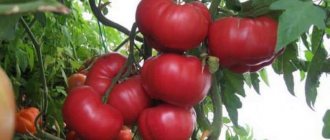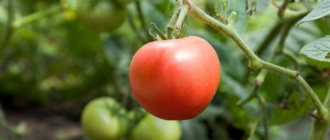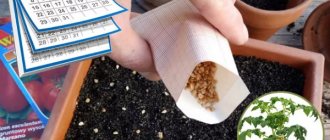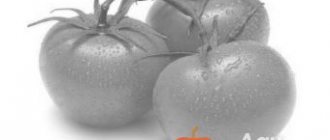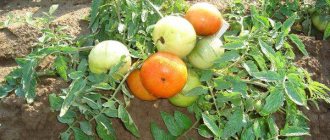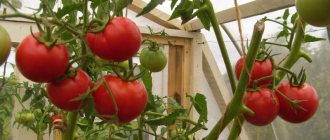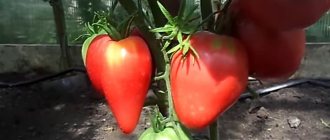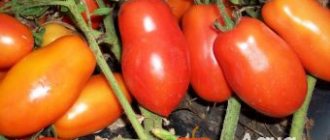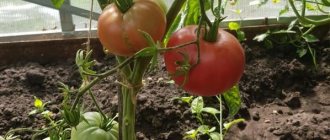Is it difficult to grow an Alpatievsky tomato?
Tomato Alpatieva 905 a is a standard determinate early ripening variety. Tomatoes are good for canning. This is one of the most low-maintenance varieties grown in central Russia. Even people who have no experience in gardening will get a good harvest of these tomatoes.
General information about the variety
Alpatiev 905 tomatoes are low-growing, growing up to half a meter, no more. The bushes are formed very compact and do not require any pinching or gartering of branches. Up to five bushes are planted per 1 m2 of area. The stems of this variety grow strictly vertically, they are densely covered with bright green fronds. The shape of the small leaves is corrugated.
The fruits are round, noticeably flattened in shape - as you see in the photo. Their color is bright red or even scarlet. They weigh a little, from 60 to 100 grams. The tomato pulp is divided into 4 segments.
Ask and receive useful advice from professional gardeners and experienced summer residents.>>
As for taste, Alpatiev tomatoes do not have an exquisite taste. However, as they say, there are no comrades according to taste.
Canned Alpatiev tomatoes are much tastier. In addition, as housewives write in reviews, they withstand heat treatment.
The second advantage is its early and friendly maturation. Harvesting can begin within 100-110 days after sowing the seeds for seedlings. From 2 to 2.5 kg of tomatoes are usually harvested from one bush.
Using the open method, these tomatoes can be grown without fear not only in central Russia, but also beyond the Urals and even in Eastern Siberia.
Alpatiev 905 tomatoes have one truly unique property. Their beneficial properties for human health are manifested not in raw, but in processed form. During heat treatment, oddly enough, the nutritional value of these vegetables does not decrease, but, on the contrary, increases. Nutritionists assure that it is advisable to digest the juice from these tomatoes.
Advantages of the variety
Harmonious ripening of fruits. The variety, according to its characteristics, practically does not react to sudden changes in ambient temperature. Easy to care for. Drought resistance. Possibility to use your own seeds for seedlings
For this, it is important to take them only from overripe fruits. Dried seeds are completely preserved until spring in paper or fabric containers. High content of sugars in the fruit pulp. Good yield.
Growing rules
Caring for Alpatiev 905 tomatoes is simple and easy. Tomatoes can be grown in beds, fields and greenhouses. The essence of care is really necessary and moderate watering, timely weeding, loosening the soil and regular fertilizing.
Most often, it is not necessary to tie up the stems of Alpatiev 905 tomatoes. Only sometimes in some bushes too many fruits are formed, then the stems are tied to a support. There is no need to do stepsoning.
There is a small peculiarity in caring for this variety. You need to start hardening off seedlings not a week before planting in the ground, but 10 days before. In addition, during seedling growth, it needs to be fed two or three times with complex mineral fertilizers.
Seedlings are planted in the ground after the threat of spring frosts has disappeared. The distance between bushes should be at least 40 cm, and between rows - at least 50 cm.
When the bushes reach a height of 15–20 cm, the lower leaves are torn off. This is done so that air does not stagnate at the base of the trunks. As you know, poor air circulation contributes to the appearance of fungal diseases.
Tomato variety Alpatieva 905A - characteristics and description of the variety
This variety is intended for those gardeners who do not like to tinker too much in the garden, but want to have delicious tomatoes grown with their own hands in their diet. Tomato Alpatieva is exactly what you need. The variety is unpretentious in care, has a universal purpose, and produces an excellent harvest every year.
Description of the variety
The standard variety belongs to the early-ripening determinate types of tomatoes and the Alpatiev tomato has a simple description. This variety looks like a low compact bush, no more than fifty centimeters, which does not require gartering or removal of stepsons. Up to five plants can be placed on an area of one square meter.
The stems are smooth and strong, the leaf mass is lush and abundant. The foliage is corrugated, medium in size with a bright green color. The inflorescences are small and neat. The central stem forms three to six inflorescences. The first appears above the eighth sheet. Subsequent ones every two leaves.
The fruits are round, slightly flattened, scarlet in color, the surface is even and smooth. Each fruit can weigh from sixty to one hundred grams. The taste is satisfactory. A prepared salad from fresh tomatoes of this variety will not really amaze ardent fans of this vegetable with its interesting taste.
Fruits of the Alpatieva 905A variety
The main advantages of the variety are industrial use; Alpatiev 905A tomatoes are very productive. In one season, you can collect up to two and a half kilograms of ripe fruits from one bush. On an industrial scale, harvesting begins one hundred and ten days after sowing the seeds for seedlings.
Characteristics and advantages of the variety
All collected reviews and characteristics indicate that this tomato variety is excellent for growing in open ground throughout our country, despite the unfavorable conditions of some regions. The qualitative advantages are obvious:
- The fruits ripen simultaneously and evenly, which is excellent for their main purpose - canning.
- Tomatoes are not afraid of sudden temperature changes, withstanding all natural disasters.
- Unpretentious and undemanding in cultivation and care, they tolerate very dry seasons well.
- The tomato variety is non-hybrid and this makes it possible to grow from collected seed material. To collect seeds, several especially high-quality fruits are left on the bush, which are brought to full ripening. After the tomatoes have become soft, remove them and grind them through a colander. The seeds are thoroughly washed and dried. The material is stored in a cool, dry place.
- Tomatoes contain special sugars that show themselves in canning. Only in its salted form can the qualitative advantages of the crop be fully appreciated. Having tasted the assorted vegetables, Alpatiev’s tomatoes receive only positive, enthusiastic reviews.
- This species boasts high resistance to diseases and pests.
Growing tomatoes
The Alpatieva 905A variety was bred by breeders in the fifties of the last century and was originally intended for industrial breeding. Due to its ease of care and excellent performance in canned form, it has won the trust of private tomato growers.
Seeds planted at the appointed time germinate evenly and smoothly, seedling material develops quickly and efficiently, without requiring close attention and serious care. Seedlings in open ground take root well and withstand all possible temperature fluctuations with dignity.
A low-growing crop does not need supports or tying. This is only necessary if the number of fruits on the bush exceeds standard norms and bends the bush to the ground. In the first two weeks of ripening, up to thirty percent of the entire crop ripens.
This variety of tomato is low-growing
The variety bears fruit excellently even in unstable cold summers, so it is in great demand for cultivation in the northern regions of the country. Here it is grown in greenhouses and greenhouses and in a short summer period high-quality and high yields are obtained.
The most important conditions for care are timely loosening of the soil, removal of weeds, systematic and regular watering. When the bush reaches twenty centimeters, all lower foliage is removed from it, protecting it from fungal diseases that may be in the soil.
If you decide to grow tomatoes on your plot, you can make a start by planting an Alpatiev tomato. Beginning gardeners will find many advantages in growing crops and will receive a good harvest.
Agricultural technology
How to grow tomatoes in open ground:
| Growing seedlings Peculiarities:
| |
| Planting in beds Peculiarities:
| |
| Feeding Peculiarities:
|
Reviews from gardeners about the Alpatieva 905 variety indicate a simple tomato taste, which does not correspond to what is stated in the register as salad. When canned, tomatoes acquire special value precisely because of their taste.
The advantages of this variety of tomatoes
The advantages of Alpatiev tomatoes are obvious:
- Simultaneous ripening of fruits. In the first 14 days, up to 30% of the total crop ripens. This is very convenient for winter canning.
- Tomatoes can withstand sudden temperature changes well.
- Drought resistance and unpretentiousness in cultivation and care.
- The possibility of growing this variety from your own seeds. This variety is not a hybrid, which allows you to save on purchasing seeds. To collect your seeds, you need to leave a few vegetables on the bush until they are completely ripe (until soft). Then the fruits are ground through a sieve, the seeds are washed, dried and left in a secluded place until next spring.
The Alpatieva 905 a tomato variety contains special sugars that open up and give the tomatoes an original taste when salted.
The description of this variety indicates the high resistance of the plant to various pests and diseases.
Retro tomatoes
We remembered White Filling, Volgogradskie, De Barao in its original form, Bull's Heart. But the tomatoes Dina, Alpatyevo and Orange Salad were especially praised.
I didn't find this type. But Dina and Alpatyevo 905A still exist!
Tomato variety Dina: review, description
The variety was bred by the Moscow Institute named after. Vavilov, zoned for Eastern Siberia, the Urals, the Far East and Central Russia.
I don’t see Dina seeds in our stores either. On the Internet they are from “Sedek” and “Search”. You can take a chance, suddenly that same Dina will grow up with beautiful yellow and tasty fruits.
Dina Tomato Seeds
Ripening period is up to 104 days in the Central region and up to 122 days in the Krasnoyarsk Territory. But it was in the Krasnoyarsk Territory that the maximum yield was recorded - 419 c/ha.
Bush height – 55-70 cm, fruits up to 300 g, average weight – 100-128 g.
The taste is excellent, the tomatoes are suitable for pickling. But there is a minus: Dina is affected by late blight and blossom end rot.
There is a variety with a similar name - Dino. Developed in France, it is also short-growing and productive, but the fruits are red and cuboid-shaped.
Tomato variety Alpatieva 905A
It was introduced a very long time ago, since it entered the State Register already in 1950. The application was submitted in 1945 by employees of VNIISSOK (Moscow Region, Odintsovo district). Today this institution is called the “Federal Scientific Center for Vegetable Growing”.
Tomato seeds Alpatieva 905 A
Productivity is good, ripening occurs 100-115 days after germination. This is what our colleague confirms.
So quickly, early and amicably the Alpatiev variety yields its harvest. The taste is not wow - just satisfactory. Another feature of the variety is that it is heavily overgrown with leaves, probably due to this it has increased cold resistance.
I also have reviews of a couple of determinate sweet cherries, but I won’t bore you. I'll do a review later. Maybe during this time someone else will recommend sweet cherry tomatoes? Not sour. Two is not enough...
Who is not with us yet, subscribe to the channel “”. Ahead are a selection of varieties of watermelons for Siberia, productive zucchini, and delicious cabbage for pickling. Everything is based on your real reviews, only the best and proven.
I'll leave you alone until the next publication. Like, write comments, share this collection on social networks.
Tomato Alpatieva
Tomato Alpatieva 905A was bred at VNIISSOK by crossing the varieties Shtambovy Alpatieva 905 and Bison 639. It was included in the State Register of Breeding Achievements of Russia back in 1950. It can be planted and grown even in the Urals and eastern Siberia. It is planted in an open area and in a greenhouse.
Characteristics and description of the tomato variety Alpatieva
Early variety. You can harvest tomatoes 100–115 days after sprouts appear. This is not a hybrid. The bushes reach a height of 0.5 m.
The stems stand straight. The foliage is highly corrugated and has a dark green tint. The first fruit cluster grows above the 7-8 leaf, the second and subsequent ones - after 1-2 leaves. 3-4 fruits ripen on one cluster.
Note! The bushes are standard, that is, stepsons do not grow on them.
Description of Alpatiev tomatoes
The fruits are round, slightly flattened, bright scarlet. Fruit weight is 60-100 g. The tomato has 4 seed chambers. It contains 5-6% dry matter and 2.6-3% sugars. It is convenient to preserve and pickle fruits, since they are smooth, do not crack, and are similar to each other. They contain special sugars that give a unique flavor when pickled. You can squeeze tomato juice.
The yield of Alpatiev tomatoes is high - up to 2-2.5 kg are harvested from 1 bush, and 146-445 centners from 1 hectare.
Pests and diseases: how to deal with them
The Rio Grande tomato variety is quite resistant to major diseases: late blight, mosaics, gray and white rot. To prevent viral and fungal diseases, it is recommended to change the soil in the greenhouse annually. For preventive purposes, the soil can be spilled with a hot aqueous solution of potassium permanganate or copper sulfate. When planning to plant seedlings in open ground, it is better to choose beds in which legumes, cabbage, and herbs (parsley, mustard greens or celery) grew.
You should not place tomatoes in areas that were occupied by other nightshades (peppers or eggplants). To prevent fungal diseases, frequent spraying of bushes with phytosporin or other non-toxic biological preparation is recommended. Mulching the soil with straw or humus, ventilating the greenhouse and moderate watering to dry the top layer of soil will help to avoid many problems.
Insecticides can destroy pests, but they can only be used before abundant flowering and formation of ovaries. Naked slugs, which often appear in vegetable gardens, can be removed by regular spraying with an aqueous solution of ammonia. Soapy water, which is used to gently wash the affected stems and leaves, helps fight aphids.
Rio Grande is worth growing for those who are taking their first steps in gardening. Original Rio Grande tomatoes are unpretentious, as the description of the variety says, they tolerate minor agrotechnical imperfections, easily tolerate heat, lack of moisture and slight acidification of the soil. Compact bushes will not take up much space in the greenhouse or garden beds and will certainly delight you with a bountiful harvest.
Tomato 'Alpatieva 905 A'
Main genus: Tomato
| Productivity |
| Ripening period |
| Soil type |
| Growing method |
| Purpose of fruits |
| Disease resistance |
| Soil ph requirements |
| Life form |
| Shape of fruits/stems/roots and tubers/heads |
| Size of fruits/stems/roots and tubers/heads |
| Cultivation region by origin |
| Vitamin content |
| Color of fruits/roots and tubers |
| Leaf/stem/head color |
| Fruit/root and tuber pulp color |
| Peel thickness |
| Frost resistance |
| Drought resistance |
| Decorative value |
| Taste of fruits |
| Shelter for the winter |
| Pest resistance |
| Habit |
| Keeping quality |
| Parthenocarpic |
| Branching pattern |
| Density and character of the pulp |
Expand all properties
Description of the plant:
Tomato 'Alpatieva 905 A' is a variety bred by the All-Russian Research Institute for Selection and Seed Production of Vegetable Crops. Approved for use in the North-Western, Central, Volga-Vyatka, Ural and East Siberian regions in 1950.
Recommended for growing in open ground.
Dimensions and growth form:
The variety 'Alpatieva 905 A' is represented by standard, determinate, erect plants. The foliage is strong. The height of the main stem is 32–44 cm. The leaf is medium-sized, dark green, highly corrugated.
The inflorescence is simple, compact, short (6–9 cm). The first inflorescence is formed above the 6-8th leaf, the subsequent ones - after 1-2 leaves. There are 3–6 inflorescences on the main stem.
Fruit:
Size, shape and color:
The fruit is flat-round and round in shape, medium in size, weighing 55–75 g. The surface is smooth and slightly ribbed. The color of the unripe fruit is green, with a dark spot at the stalk; the color of the ripe fruit is red. The number of nests is 3–6, the location is correct.
The taste of the fruit is satisfactory.
Ripening time and yield:
Tomato 'Alpatieva 905 A' is an early ripening variety. The period from full germination to fruit ripening is 100–115 days. Productivity 1.4–4.4 kg/m2.
Directions for use:
Recommended for fresh consumption and pickling.
The end of the twentieth century: the phenomenon of the Red Arrow and the Solar
The dashing 90s have arrived. Breeder-authors retired, research institutes fell apart. A flood of fakes poured in, and buying real seeds of the listed varieties became problematic. Then, at the suggestion of Professor S.I. Ignatova. Our company began to grow seeds of the F1 hybrid Red Arrow.
Tomato F1 Red Arrow. Photo: fermilon.ru, vparnike.ru, ruscemena.ru, pomidorchik.com
The seeds were grown in abundance. To solve the problem with their use, they began to grow seedlings. And the Red Arrow rushed through the plots.
This is a very productive and stable hybrid. The plant has a semi-determinant growth type and practically does not require pinching after the first inflorescence.
Early ripening - from germination to harvest 98-110 days. The fruits are aligned, oval-round, dense, smooth; a dark green spot forms at the stalk before ripening. Fruit weight 90-130 g, excellent taste. Resistant to major diseases and adverse conditions. Resistance to temperature changes allows you to grow the hybrid at an earlier time under the film, when there are sharp drops in temperature. The plants are shade-tolerant, so denser planting is possible and saves space in the greenhouse. The fruits are suitable for salads and canning.
But Red Arrow is still a semi-determinate hybrid. What does this mean: it is completed not with 3 brushes, but with 4-6 brushes. And often it lacks warmth in our northern summer.
And then one trading company from Yaroslavl offered seeds of the Solnechny variety. For several years, buyers came with one demand: “I want some sunshine.”
Tomato Sunny. Photo: semena-tut.ru, sorta-rasteniy.ru
The variety was bred by the Oryol State Regional Agricultural Experimental Station by crossing the varieties Skorospelka 172 x Altai Salting with subsequent directed selection. Zoned in 1977.
Early ripening - fruit ripening occurs 93-112 days after emergence. The plant is semi-standard, determinate, 30-40 cm high. The fruits are elongated-oval, smooth, red, weighing 38-52 grams. Number of nests 3-4.
The taste is satisfactory and good. Valued for early ripeness, smooth ripening of fruits, high yield, and transportability of fruits.
Sunny bore fruit well in open ground. True, the fruits were rather small, but there were a lot of them on the plant. But they ripened quickly and fit well in jars.
Description of the variety
| Variety name | Octopus F1 |
| general description | Late-ripening indeterminate hybrid |
| Originator | Japan |
| Ripening period | 140-160 days |
| Form | Round |
| Color | Red |
| Average weight of tomatoes | 110-140 grams |
| Application | Universal |
| Productivity of the variety | 9-11 kg per bush |
| Features of cultivation | Shows the best results in hydroponic greenhouses |
| Disease resistance | Resistant to most diseases |
Tomatoes "Octopus F1" are an F1 hybrid plant. There are no analogues or hybrids of the same name in the world yet, remaining unique and inimitable. True, Russian breeders were close to creating a similar phenomenon. At the end of the 80s of the last century, from the seeds of tomatoes of the Podarok variety, they bred tomato trees, from each of which they collected 13 kg of fruit. The project had to be suspended due to perestroika in the country. As a result, it remained unfinished.
Sprut tomatoes are an indeterminate plant. In 1–1.5 years, its branches can grow several meters in length. The crown area averages from 45 to 55 square meters, and the height of the tree varies between 3–5 meters. It is a late-ripening variety; the fruits begin to ripen 140–160 days after planting the seeds. Therefore, seeds for seedlings must be planted at the end of February.
As a tree, the Sprut variety can only grow in greenhouses for year-round use. When grown in open soil, you can only get an ordinary tall tomato bush.
Tomatoes of this variety are racemonic. From 4 to 7 fruits are formed on each cluster, and a new cluster is formed after 2–3 leaves. Breeders note that all tomatoes turn out smooth and of the same size. The average weight of each tomato remains between 110–140 g.
The Octopus tomato variety has a round shape, slightly flattened on top. The color is distinguished by its richness and purity of red. The fruit usually consists of 6 chambers. The dry matter content is about 2%, which is why tomatoes have excellent taste. Strong and fleshy tomatoes can be stored for a long time in a cool room. The fruits are quite capable of staying fresh until the New Year holidays.
You can compare the weight of the fruits of this variety with other varieties in the table below:
| Variety name | Fruit weight |
| Octopus f1 | 110-140 grams |
| Morozko | 50-200 grams |
| Wonder of the world | 70-100 grams |
| Red cheeks | 100g |
| Inseparable hearts | 600-800 grams |
| Red Dome | 150-200 grams |
| Black Heart of Brad | up to 1000 grams |
| Siberian early ripening | 60-110 grams |
| Biyskaya Rose | 500-800 grams |
| Sugar cream | 20-25 grams |
Read on our website: how to get a high yield of tomatoes in open ground?
How to grow delicious tomatoes in a greenhouse in winter? What are the subtleties of agricultural technology for early varieties?
Characteristics of this variety
This variety of tomatoes is a low bush (no higher than 50 cm), very compact and does not require pinching or staking. 4-5 such bushes fit on one square meter. The foliage of the bushes is strong, the stems are erect. The leaves are medium-sized, rich green in color, corrugated. Simple inflorescences, neat and small, form on the branches. 3-6 inflorescences are formed on the central stem, the first inflorescence is formed above the 7-8 leaf, the next ones - every 1-2 leaves.
The fruits have a regular round shape, slightly flattened. Bright scarlet color. The size of the fruit varies from 60 to 100 grams. Each vegetable contains 4 nests. The surface of the vegetable is smooth. The taste cannot be called excellent, but it can be called satisfactory. If you want to please yourself with a fresh tomato salad, but at the same time you are very picky about taste, then such tomatoes are unlikely to surprise you with anything.
But they are quite suitable for canning. The tomatoes are compact and uniform in size, resistant to cracking and look great in jars, unlike other varieties that are more tasty and fleshy, but also larger and unsuitable for winter storage.
The main value of this variety is industrial. This variety is very productive. During the fruiting season, it is possible to collect 2-2.5 kg of ripe tomatoes from one bush. Harvesting begins 100-110 days after planting the seeds.
The declared characteristics of this variety indicate the possibility of its cultivation in open soil, both in the central zone of our country, and in the Ural Territory and even in Eastern Siberia.
It is important to know! Tomatoes have very beneficial properties for the human body, but unlike other vegetables, in tomatoes these properties are much stronger when boiled. Therefore, among the many juices, the only tomato juice is recommended to be taken in digested form, and not freshly squeezed.
Growing tomatoes
All activities for growing the “Alpatieva” 905 a variety are standard.
How to prepare seeds?
Basic recommendations for preparing seed material:
- Before sowing, the seeds are calibrated. To do this, they are soaked in a saline solution for 15 minutes. Seeds that float to the surface are discarded;
- Afterwards, a disinfection procedure is carried out using a weak manganese solution;
- It is advisable to germinate the seed material. It is placed in a moistened cloth on a saucer and left to germinate.
IMPORTANT: Do not allow the cloth to dry out.
Sowing seed material
How to sow seeds correctly:
- Seeds for seedlings are sown in late March;
- Two or three seeds are sown in containers, deepened by 1-1.5 cm, with an interval of 2 cm. Sprinkle a 1 cm layer of soil on top;
- Moisten the soil with a spray bottle;
- Cover the pots with film and leave in a warm and well-lit place;
- Raise the film daily to ventilate the plantings;
- Watering is carried out as needed, without allowing the soil to dry out;
- After the first shoots appear, the film is removed;
- In the phase of two true leaves, the seedlings are planted in separate pots;
- During the entire period of growing seedlings, two or three feedings are carried out using complex fertilizers;
- 10 days before the intended planting in a permanent place, they begin to harden the young seedlings.
REFERENCE: To prepare the soil mixture, mix compost or humus, garden soil, peat and sand. Add 40 grams of fluff lime per bucket of gunta. You also need to add 10 grams of potassium sulfate, 30 grams of superphosphate, 10 grams of urea. Afterwards, containers for seedlings are filled with this substrate.
Rules for planting seedlings
Instructions for planting seedlings:
- Planting in greenhouse structures equipped with a heating system begins in mid-April. Planted in unprotected soil after the risk of possible return frosts has passed, mainly in mid-May;
- When planting, use the recommended planting pattern: 40x50 cm, i.e. There are no more than 4-5 seedlings per 1 m2.
This is interesting: Tomato Altai Orange
Features of cultivation
First, at the end of March, you need to sow the seeds. It is better to germinate them first. You should place a moistened napkin on a plate, sprinkle seeds on it, and wait until they germinate.
For the substrate you need to mix compost or humus, garden soil, peat, sand. Pour another 40 g of fluff lime into 1 bucket of soil. Add 10 g of potassium sulfate, 30 g of superphosphate, 10 g of urea there. Then pour this mixture into peat cups.
Landing:
- Place 2-3 seeds on top of each glass. Sprinkle with 1 cm of soil.
- Moisten the soil with a spray bottle.
- Cover the plantings with film. Place in a warm and bright place.
- Every day you need to lift the film to ventilate.
- Moisten the soil as it dries.
- When shoots appear, the film should be removed.
It is necessary to plant seedlings in the soil at the end of May, making 40 cm indentations between them. 4-5 plants can be planted per 1 m². Alpatiev tomatoes are very easy to grow. Since the bushes are not tall, they do not need to be tied up; stepsons do not grow on them. Therefore, care consists of timely watering, fertilizing, and also loosening the soil after watering.
Important! When the bushes grow to 15–20 cm, the lower leaves should be torn off.
Considering that the variety is resistant to attacks by pests and diseases, sudden changes in weather, and drought, then its cultivation does not require effort. Therefore, even a novice gardener can grow Alpatiev tomatoes.
Yield varieties of tomatoes
The productivity of tomatoes depends on many factors - soil fertility, climate, and compliance of the variety with growing conditions. We also must not forget that the most delicious and productive tomatoes are obtained as a result of proper care. Choosing the best from thousands of varieties is not an easy task, but it’s worth asking which tomatoes are the most productive.
Yield varieties for open ground
It is believed that productive tomato varieties are those that allow you to get more than 6 kg per 1 m2
At the same time, for maximum yield, it is important to observe the conditions suitable for a particular variety. First, let's look at the most productive tomato varieties for successful cultivation in open areas:
- Gribovsky
. A popular tomato variety, it is classified as early-ripening and low-growing. The Gribovsky soil variety is characterized not only by high yield, but also by such important characteristics for cultivation as frost resistance and disease resistance. Medium fruits weigh up to 90g, they are round and bright red. - Alpatieva 905a
. High-yielding low-growing tomatoes of the Alpatieva 905a variety are classified as mid-season. These are round, reddish tomatoes, suitable for canning and salads; they can be stored for quite a long time. One of the advantages of the variety is its resistance to many diseases of viral origin. - Present
. The variety is more suitable for the southern regions, but gives good yields in the central zone. The gift belongs to the mid-season tomato varieties, is universal in use and not very demanding to grow. It is possible to grow without preparing seedlings. Fruit weight is about 100-120 g, flat-round shape, red color. - Waterfall
. An early-ripening, tall variety of tomatoes that requires attention, as it is prone to diseases. It is better to grow the Waterfall variety under film. It is distinguished by an abundance of small egg-shaped fruits of orange color. Universal in use, Waterfall is best preserved with whole fruits. - Kuban standard 220.
It is a representative of mid-late varieties and is widely used due to its taste. The moderate sweetness and rich taste of this variety are often used to make tomato paste. The fruits on a powerful bush grow large, flat-round, colored orange-red.
Yield varieties of tomatoes for greenhouses
Now let’s look at which tomato varieties are the most productive among those grown in greenhouses:
- Major
. A mid-early, tall variety of tomatoes, characterized by resistance to disease. The fruits are quite fleshy and sweet, due to which the variety is considered a salad variety. The average weight of each Major variety tomato is from 200 to 300 g. The tomatoes are raspberry-pink in color and are well preserved. - Eagle beak.
One of the very productive varieties of tomatoes can also be grown in open ground, although the yield is higher in a greenhouse. A tall, large-fruited variety, the weight of one tomato can reach 800 g. It got its name due to the elongated, curved shape of the fruit, reminiscent of a bird's beak. - De Barao
. A very popular productive tomato variety for greenhouses, it is a vigorous variety. Medium-sized fruits weighing 60-70g grow on clusters of 5-7 pieces and have an elongated shape
and pinkish color.
- Budenovka
. A medium-early large-fruited tomato variety that does not require special care in care is practically not susceptible to infection. The tomatoes are very fleshy, red, slightly sweet, weighing 300-400g. The variety bears fruit abundantly regardless of seasonal conditions. - Pink honey
The bush grows tall and produces very large fruits with a pronounced sweet taste without a sour taste. From the name it is clear that the fruits are pink and shaped like a heart. The variety is rarely used for preparations; when fresh, it reveals the taste better.
womanadvice.ru
Determinate tomatoes for open ground
Tomato "Little Red Riding Hood"
An early-ripening tomato variety for the south and mid-ripening for more northern regions with a growing season of 95 days. The bush is 70 cm high and does not require pinching. The tomato does not require special feeding, but will appreciate the application of fertilizers. The yield of one bush is 2 kg.
The tomatoes are not large, maximum 70 g. The skin of the tomatoes is thin, they are well suited for fresh consumption or for preparing assorted vegetables for the winter. Not very good for whole-fruit canning due to the thin skin.
The variety is resistant to many tomato diseases, including late blight, and to temperature fluctuations. Can tolerate short-term drops in temperature.
Tomato "Alpatieva 905 a"
Mid-season tomato variety. The bush is low, up to 45 cm, determinate, standard. For this tomato, mid-ripening is determined by the southern regions, since its growing season is 110 days, although, according to the register, it is recommended for outdoor cultivation both in the Middle Zone and in the Ural region and Eastern Siberia.
Small tomatoes, 60 g. 3-4 ovaries are formed on one brush. The variety is productive and has industrial value. 2 kg of tomatoes are removed from one bush, planting 4-5 bushes per m².
Densely leafy, upright tomato bushes do not require pinching and need staking only when there are a very large number of tomatoes. After the bush reaches a height of 20 cm, the lower leaves are torn off.
In the register, the tomato variety is declared as a salad variety, although it will not impress with its special taste. The tomato has a characteristic tomato taste. But it is good for winter preparations.
Purslane: medicinal properties and contraindications
For this reason, the variety has advantages over other salad tomato varieties.
The advantages of the variety are also:
- friendly ripening (in the first 2 weeks up to 30% of the harvest);
- resistance to sudden temperature changes;
- undemanding to growing conditions, which is why the Alpatieva 905 a is an excellent simulator for novice gardeners.
Since this is a variety and not a hybrid, its seeds can be saved for next year. To collect seeds, 2-3 tomatoes are left on the bush until fully ripe. You need to remove them before they begin to creep under your hand.
The seeds are removed from the tomato and left to ferment for 2-3 days, after which they are washed well with clean water and dried. Tomato seeds remain viable for 7-9 years. But the optimal age of tomato seeds is from 1 to 3 years. Further, germination begins to decline.
Tomato "Caspar F1"
Determinate high-yielding tomato hybrid, bred in Holland, with a growing season of 100 days. The height of the bush is 0.5-1 m. The stem of “Caspar F1” tends to creep along the ground and produce a significant number of stepsons. To avoid excessive growth of the bush, it is formed by pinching into two stems.
It is precisely breaking off the stepson in this way that inhibits the emergence of a new shoot in the same place. There is no need to pluck or pull out the stepson.
8 bushes of this tomato variety are planted per square meter. The bush must be tied up so that the tomatoes do not come into contact with the ground.
Tomatoes are red, elongated, weighing 130 g. Designed for open ground.
A new tomato variety, included in the register only in 2015. Suitable for cultivation in all regions of Russia. The hybrid is undemanding to care and is suitable for beginner vegetable growers. Loves abundant and frequent watering.
The tomato is considered universal, but when preparing salads, the tough skin must be removed. Well suited for preservation, as the thick skin prevents the tomato from cracking. Ideal for canning in its own juice.
Resistant to tomato diseases and pests.
Tomato "Junior F1"
An ultra-early ripening tomato hybrid from, producing fruits already 80 days after germination. Designed for cultivation in small farms and subsidiary plots.
The bush is superdeterminate, 0.5 m high. 7-8 ovaries are formed on the brush. Bushes of this tomato are planted 6 pieces per m².
Tomatoes weighing up to 100 g. Productivity 2 kg per bush.
With a large number of fruits, tomatoes grow small, with a small number, large ones. The total mass per unit area remains virtually unchanged.
“Junior” is a universal variety of tomatoes, recommended, among other things, for fresh consumption.
The advantages of the hybrid are:
- crack resistance;
- precocity;
- good taste;
- resistance to diseases.
Due to the early ripening of tomatoes, the harvest is harvested even before late blight spreads.
Bush care
Basic measures for further care of tomato plantings:
- Regular watering. It is preferable to water in the evening using warm water;
- Timely loosening. Be sure to loosen the soil after rainfall and watering in order to improve soil aeration and prevent the formation of a crust on the soil surface;
- Removal of weeds;
ATTENTION: Since the variety is low-growing, the plant is not pinched or tied up.
- Mulching. Soil mulched with straw or mowed grass retains moisture well;
- When tomato bushes reach a height of 15-20 cm, it is necessary to remove the lower leaves;
Reviews about the variety from those who planted
Tomato "Alpatieva" 905 a has both positive and negative reviews. Some are satisfied with the variety’s resistance to sudden temperature changes, while others are not delighted with the taste characteristics of the fruit. However, everyone likes the unpretentiousness of the tomato variety in care.
Beginner gardeners can cope well with growing the tomato variety “Alpatieva” 905a, since it does not require constant effort and much attention. In addition, as experienced vegetable growers generally admit, growing standard tomato varieties is quite exciting.
